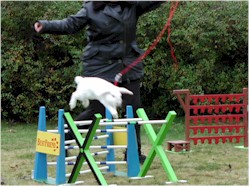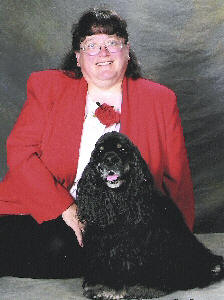Rabbit Agility
|
|
|
|
Hop to it...
|
| For what it is worth, the rabbits
usually move fairly slowly on course, and the handlers usually do some sort of shuffle
step behind them. There are times within a run when the rabbit will actually run for a
while, but most of them stop lots of times during a run and have to be re-started in a
forward direction again. The handlers aren't supposed to make contact with the rabbit
when they are scooting them forward, but I have had to excuse more than one kid from the
course for literally kicking their rabbit to get them to move down the course.
According to a Rabbit Agility web site, there are certain breeds that should not be used for Rabbit Agility or Rabbit Hopping. English Lops could injure their ears while trying to run the course. Angora Rabbits would probably pick up every stick, leaf and any trash between the start and the finish line. The Giant breeds can jump high and run fast, but the jolt to their joints are hard on their health. |
Bunny HoppingCheck out Rabbit Agility in You-Tube. Bet you never thought that a rabbit would be so happy and willing to play this way. |
Training
And it is always really fun when they run rabbit agility outdoors on grass. Few rabbits
actually run the course, and most stop to have dinner instead. hence the frustrated handlers
being more likely to use some physical force. It would be a little like filling up the entire
dog agility ring about 6in. deep with Milk Bones, and asking the dogs to run on a surface of
dog biscuits. A few will, but most will choose to snack, at least now and then throughout the
course.
When training rabbits, they most often use yogurt drops - occasionally carrots or bread cubes work - on equipment much like we would use a target to train a dog. When asked how they get such a good performance from their rabbits for the video on You-Tube, FuzzFarm wrote: -
I pay them! Filbert likes treats like rabbit pellets and little pieces of Cheerios. He also really likes to explore the neighbor's yard after we practice hopping. Muffy, as you can see, wasn't very cooperative with my training plan but once I realised she had a better, cuter plan, we got along much better. Muffy works for snuggles or treats depending on her mood. Mattie was born to hop. She hopped fences for fun before she started hopping hurdles. Her pay check is a 'go home' cue.
 A
rabbit agility course is quite different from a dog agility course. They go in a straight line
most frequently, and even in the 'curved' division, it usually just zig zags down a long skinny
space. It's nothing at all like we do with dogs with several crosses of the path. If you wish
to turn the rabbits on course, it is best done in a tunnel, because rabbits just don't take
direction from their handlers well! Most rabbits are in the on-leash division a really long
time before going off leash.
A
rabbit agility course is quite different from a dog agility course. They go in a straight line
most frequently, and even in the 'curved' division, it usually just zig zags down a long skinny
space. It's nothing at all like we do with dogs with several crosses of the path. If you wish
to turn the rabbits on course, it is best done in a tunnel, because rabbits just don't take
direction from their handlers well! Most rabbits are in the on-leash division a really long
time before going off leash.
The A-frame and rabbit walk they use is fairly long - bout 3 feet long - not very steep ramps, and is always carpeted. They do not do a teeter, weave poles or table. Rabbit equipment is much shorter than dog equipment to say the least. I really do not like their long jump design much. The bars often fall off of the regular jumps too easily - worse than anything I have ever seen in dog agility. Basically it's a sport still in it's infancy, and not popular enough for anyone to have developed alternate equipment designs... yet.
 About
the author...
About
the author...
Leona Hellesvig used to be a rabbit breeder about 25-30 years ago, but does not have any
rabbits currently. In days gone by, she raised and showed New Zealands, Californians, Satins,
Rex, French Lops, and Silver Martins in ARBA (American Rabbit Breeders Association) shows. In
the dog agility world, her focus is mostly with 4-H dog project in Minnesota, working with the
only Junior Handler Agility league in the USA, and teaching at Bloomington Obedience Training
Club.
She is also a USDAA judge.
Leona also wrote one of our classic agility articles several years back called Speeding Up a Slow dog.
First posted: 08/04/07
|
[bottom.htm] © Copyright Agilitynet |